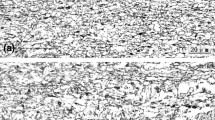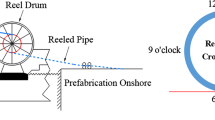Abstract
Plastic deformation capacity parameters affect the deformability of steel in the plastic stage and then affect the limit pressure of pipelines. This paper investigates the influence of plastic deformation capacity parameters on the limit bearing capacity of pipelines. These parameters include yield-to-tensile ratio (\(\sigma_{y} /\sigma_{u}\)), percentage uniform elongation (\(\delta\)) and strain hardening exponent (n). Based on the Swift strain hardening model, the relational expression of the plastic deformation capacity parameters is theoretically deduced. Ninety-five groups of material tensile test data have been collected. Based on these test data, the variation tendency of the plastic deformation capacity parameters has been analyzed statistically, and the empirical formula of the key parameters has been fitted numerically. Twenty groups of finite element examples are designed to analysis the influence of yield-to-tensile ratio and uniform elongation on the limit pressure of pipeline. Results show that, with the improvement in strength grade of steel, the plastic deformability of steel decreases; the recommended critical plastic deformation capacity indexes are: (1) pipeline steel below X65, \(\sigma_{y} /\sigma_{u}\) ≤ 0.85 and \(\delta\) ≥ 10%; (2) pipeline steel for X70–X80, \(\sigma_{y} /\sigma_{u}\) ≤ 0.93 and \(\delta\) ≥ 8%.













Similar content being viewed by others
Abbreviations
- \(\sigma_{y}\) :
-
Yield stress
- \(\sigma^{\prime}\) :
-
Engineering stress
- \(\sigma_{y}^{'}\) :
-
Engineering yield stress
- \(\sigma_{u}\) :
-
Ultimate tensile stress
- \(\sigma_{u}^{'}\) :
-
Engineering ultimate tensile stress
- ε:
-
Strain
- \(\varepsilon^{\prime}\) :
-
Engineering strain
- \(\varepsilon_{y}\) :
-
Yield strain
- \(\varepsilon_{y}^{'}\) :
-
Engineering yield strain
- \(\sigma_{y} /\sigma_{u}\) :
-
Yield-to-tensile ratio
- \(\delta\) :
-
Percentage uniform elongation
- \(\delta_{y}\) :
-
Percentage uniform elongation, when \(\sigma = \sigma_{y}\)
- \(\delta_{u}\) :
-
Percentage uniform elongation, when \(\sigma = \sigma_{u}\)
- \(\delta_{b}\) :
-
Percentage elongation after fracture
- \(\varPsi\) :
-
Percentage reduction of area
- \(\varPsi_{y}\) :
-
Percentage reduction of area, when \(\sigma = \sigma_{y}\)
- \(\varPsi_{u}\) :
-
Percentage reduction of area, when \(\sigma = \sigma_{u}\)
- \(n\) :
-
Strain hardening exponent
- K :
-
Strain hardening coefficient
- \(A_{0}\) :
-
Original sectional area
- \(A\) :
-
Fracture sectional area
- \(l_{0}\) :
-
Original length
- \(l\) :
-
Fracture length
- \(P_{\text{Limit}}\) :
-
Limit pressure
References
A.C. Bannister, J.R. Ocejo, F. Gutierrez-Solana, Implications of the yield stress/tensile stress ratio to the SINTAP failure assessment diagrams for homogeneous materials. Eng. Fract. Mech. 67, 547–562 (2000)
D.P. Updike, A. Kalnins, Tensile plastic instability of axisymmetric pressure vessels. J. Press. Vessel Technol. 120, 6–11 (1998)
W.A. Maxey, Y/T significance in line pipe, in Proceedings of the 7th Symposium on Line Pipe Research, Houston, Texas, October 14–16, 1986, Paper 9 (1986)
W. Sloterdijk, The influence of the yield-to-tensile ratio on pipeline behaviour: a literature survey, in Proceedings of the Eighteenth Biennial Joint Technical Meeting on Line Pipe Research, EPRG/NG-18, Paris, France, May 14–17, 1991, Paper 34 (1991)
W. Sloterdijk, The influence of the yield-to-tensile ratio on deformation controlled pipeline behaviour, in Proceedings of the 10th Biennial Joint Technical Meeting on Line Pipe Research, EPRG/NG-18, Cambridge, UK, April 18–21, 1995, Paper 2 (1995)
B. Ma, J. Shuai, X.-K. Li et al., Advances in the newest version of ASME B31G-2009. Nat. Gas. Ind. 31(8), 112–115 (2011)
B. Ma, J. Shuai, Analysis on the latest assessment criteria of ASME-2009 for the remaining strength of corroded pipelines. Fail. Anal. Prev. 16(11), 666–671 (2011)
J.F. Kiefner, Corroded pipe: strength and repair methods, in 5th Symposium on Line Pipe Research, Houston, Texas, Pipelines Research Committee of the American Gas Association, Houston, Texas, pp. 20–22 (1974)
R.W.E. Shannon, The failure behavior of line pipe defects. Int. J. Press. Vessel. Pip. 2, 243–254 (1974)
J.B. Choia, B.K. Goo, Development of limit load solutions for corroded gas pipelines. Int. J. Press. Vessels Pip. 80, 121–128 (2003)
M. Law, G. Bowie, L. Fletcher, Poisson’s Induced axial stresses in restrained pipelines: their effects on yielding and subsequent plasticity. J. Pipeline Integr. 4(1), 5–12 (2005)
G. Stewart, F.J. Klever, An analytical model to predict the burst apacity of pipelines, in Proceedings of the International Conference of Offshore Mechanics and Arctic Engineering (OMAE), Houston, TX, Vol. 5, pp. 177–188, February 27 March 3 (1994)
L. Zheng, S. Gao, Production and application of high strength and high toughness pipeline steel with acicular ferrite. Iron Steel 40, 688–693 (2005)
C.W. Petersen, K.T. Corbett, D.P. Fairchild et al., Improving long distance gas transmission conomics: X120 devlopment overview, Denys Reds, in Proceedings of the 4th International Pipeline Technology Conference, Ostend (Scientific Surveys Ltd., Belgium, 2004), pp. 3–30
M. Law, G. Bowie, L. Fletcher, Burst Pressure and Failure Strain in Pipeline-Part 2: Comparisons of Burst-Pressure and Failure-Strain Formulas [J]. Journal of Pipeline Integrity 3, 102–106 (2004)
H.J. Kleemola, M.A. Nieminen, On the strain-hardening parameters of metals. Metallurgical Transactions 8(5), 1863–1866 (1974)
W.E. Cooper, The significance of the tensile test to pressure vessel design [J]. Weld Res Suppl 1, 49–56 (1957)
C.E. Jaske, Development and evaluation of improved model for engineering critical assessment of pipelines, in Proceedings of International Pipeline Conference (ASME, Calgary, 2002)
Ma. Bin, S. Jian, D. Liu et al., Assessment of failure pressure of high strength pipeline with corrosion defects. Eng. Fail. Anal. 32, 209–219 (2013)
Ma. Bin, S. Jian, D. Liu et al., A finite-element-based analysis of the accuracy in bursting tests predicting the ultimate load of a buried pipeline. Nat. Gas. Ind. 33(6), 108–112 (2013)
B.A. Chouchaoui, R.J. Pick, D.B. Yost, Burst pressure predictions of line pipe containing single corrosion pits using the finite element method, in 11th International Conference of Mechanic and Arctic Engineering, Calgary, Canada. Calgary: ASME, (V-A), pp. 203–210 (1992)
Author information
Authors and Affiliations
Corresponding author
Rights and permissions
About this article
Cite this article
Ma, B., Shuai, J. Influence of Plastic Deformation Capacity on Failure Behavior of Pipelines. J Fail. Anal. and Preven. 18, 508–518 (2018). https://doi.org/10.1007/s11668-018-0414-8
Received:
Accepted:
Published:
Issue Date:
DOI: https://doi.org/10.1007/s11668-018-0414-8




